Hintergründe zum Russisch-Ukrainischen Krieg – Prof. em. Dr. Christian Hacke, 05.06.23


| 262.323 Aufrufe Live übertragen am 05.06.2023 Die beabsichtigten und unbeabsichtigten Folgen des Krieges unter militärischen, politischen, wirtschaftlichen und gesellschaftlichen Aspekten stehen im Mittelpunkt der Analyse. Entscheidend für den Ausgang des Krieges ist die Frage, ob es aus Erschöpfung beider Seiten zu einem Verhandlungsfrieden kommt, der beide Seiten zu Zugeständnissen zwingt oder ob bei einseitiger Niederlage der Sieger die Nachkriegsbedingungen diktieren wird. Zu berücksichtigen ist auch, dass es sich um zwei Kriege handelt, dem ukrainischen Verteidigungskrieg gegenüber Russland und dem Wirtschaftskrieg zwischen dem Westen und Russland. Die Wechselwirkung zwischen beiden verweist auf die Gefahr der Eskalation des Krieges und die weltpolitische Dimension seiner Folgen |
NATO Confirms that Ukraine “War Started in 2014”. “Fake Pretext” to Wage War against Russia? To Invoke Article 5 of Atlantic Treaty?
| Statements of NATO Secretary General Stoltenberg By Prof Michel Chossudovsky On September 7, 2023, NATO’s Secretary General Jens Stoltenberg in a presentation to the European Parliament, formally acknowledged that: the war didn’t start in February last year. It started in 2014.” This far-reaching declarationconfirms his earlier statement in May 2023 to the effect that the Ukraine War didn’t start in 2022”, “The war started in 2014”. Speaking on behalf of NATO, what this statement implies is that US-NATO was already at war in 2014. It also tacitly acknowledges that Russia did not “initiate the war” on Ukraine in February 2022. The purpose of this is to prevent war” In a twisted irony, in his presentation to the European Parliament, Stoltenberg portrays “the purpose” of the Ukraine war, which has resulted in more than 300,000 casualties as a means “to prevent war”. |

NATO chief debates with Parliament about European security
| 7.787 Aufrufe Live übertragen am 07.09.2023NATO Secretary General Jens Stoltenberg will address Parliament’s foreign affairs committee and security and defence subcommittee. The exchange will allow Members of the European Parliament to discuss with the Secretary General the latest developments in Russia’s war of aggression against Ukraine and highlight the importance of the EU’s strategic partnership with NATO. The discussion will come shortly after the NATO summit in Vilnius where heads of state and government of the North Atlantic Alliance again reaffirmed the enduring transatlantic bond, unity, cohesion, and solidarity at a critical time for international peace and stability. Allies also committed to continue cooperating closely with the European Union in order to make the Euro-Atlantic area and the broader neighborhood more secure. |
Putins Motive
Die NATO Osterweiterung: Ursache des Konflikts
| Hier die fünf Motive, die dazu geführt haben dürften, dass der russische Präsident uns auf diese archaische Art mitteilt: Bis hierher und nicht weiter. |
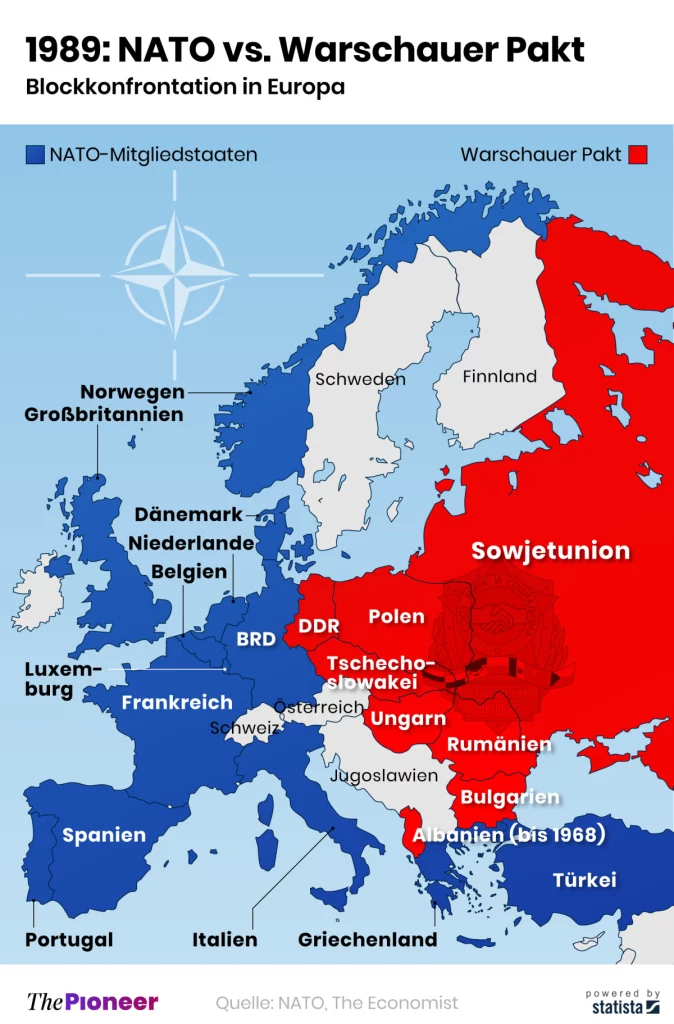
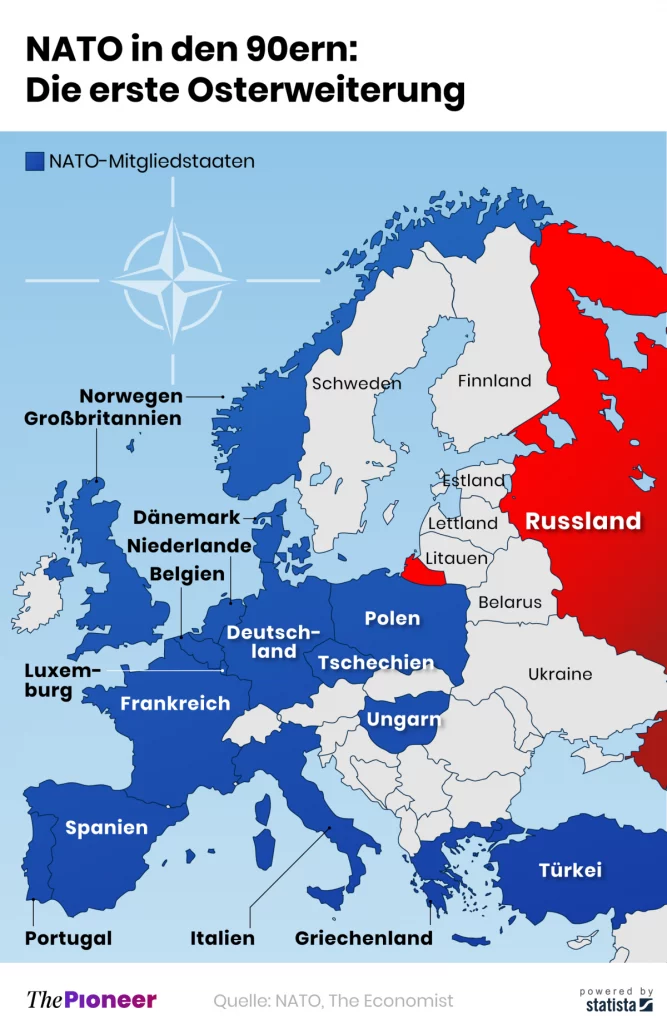
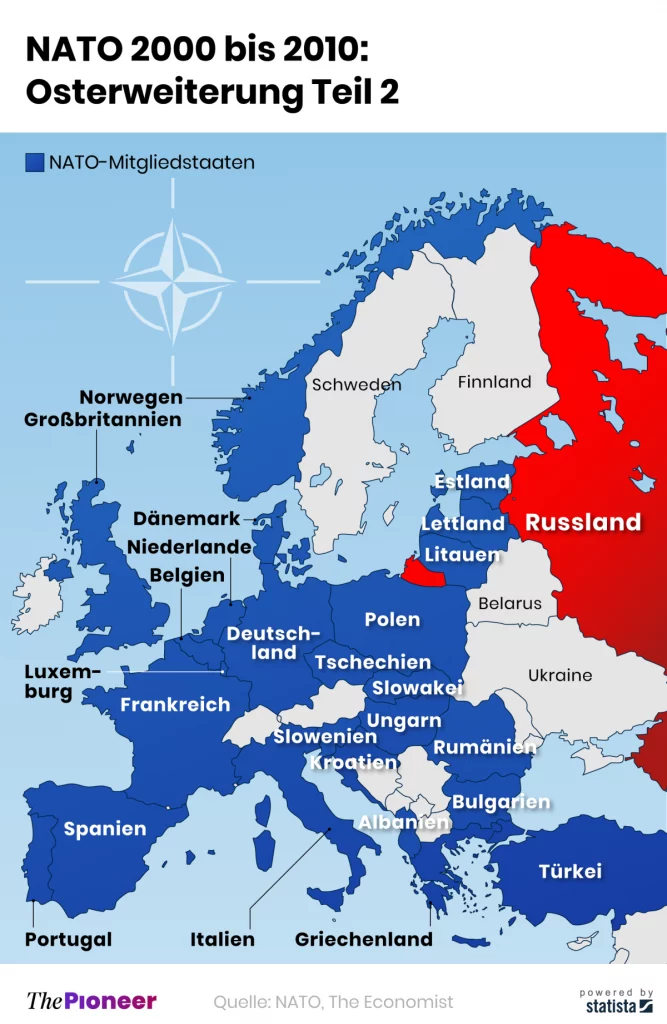
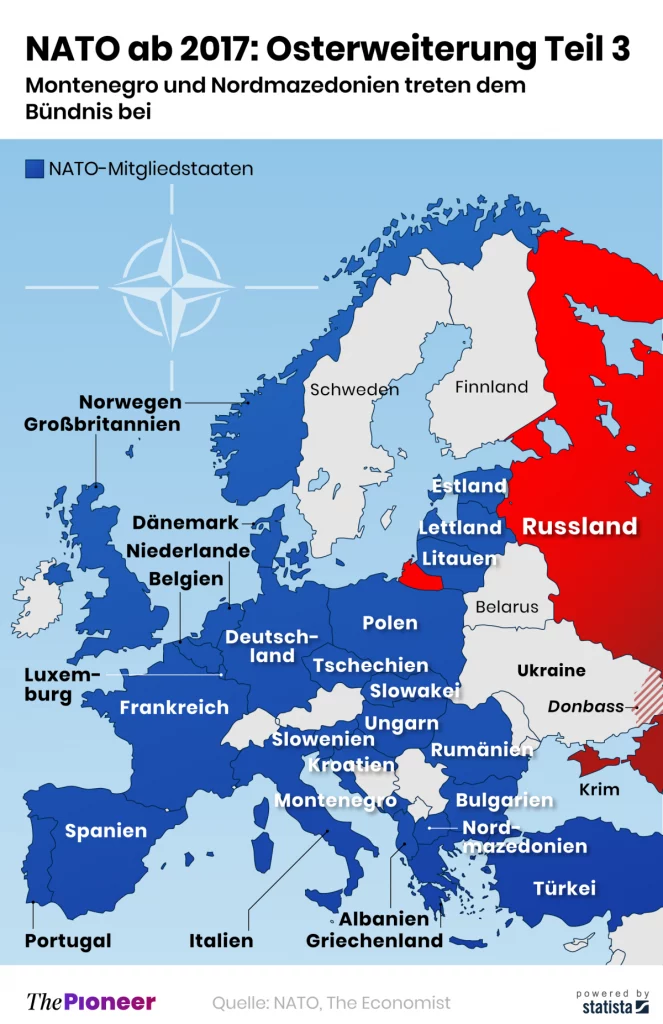
| 1. Die NATO hat sich seit der Implosion der Sowjetunion um weitere 14 Mitglieder auf nun 30 Staaten mit insgesamt 945 Millionen Einwohnern und 25 Millionen Quadratkilometern Fläche ausgedehnt. Die Osterweiterung war die größte Landnahme des westlichen Verteidigungsbündnisses – ohne, dass ein einziger Schuss gefallen wäre. Moskau grummelte, aber wehrte sich nicht. 2. Die Sicherheit aller Staaten in der euro-atlantischen Gemeinschaft ist unteilbar“, heißt es in der Erklärung des Nato-Russland-Rates von 2002, dem Russland angehört. Doch dieser Terminus von der Unteilbarkeit der europäischen Sicherheit wurde nie gelebt. Es gab für keinen der NATO-Erweiterungs-Schritte eine Konsultation mit der russischen Seite. Der Westen handelte bewusst einseitig. Es galt die Maxime: Alles ist teilbar. Auch die Sicherheit. 3. Die nächsten logischen Schritte der Osterweiterung wären die NATO-Mitgliedschaften von Finnland und Schweden; selbst die der Ukraine ist formell nicht ausgeschlossen. Damit würden die letzten Pufferstaaten im Vorhof der Russischen Föderation in die Hände des westlichen Militärbündnisses fallen. Die NATO könnte ihre atomaren Kurzstreckenraketen 500 Kilometer von Moskau entfernt in Stellung bringen. In einer vergleichbaren Situation, der von den Russen geplanten Atomwaffen-Stationierung auf Kuba, hat US-Präsident John F. Kennedy im Oktober 1962 mit der Kubakrise, die im Ultimatum per Seeblockade gipfelte, einen dritten Weltkrieg riskiert: In einer vergleichbaren Situation, der von den Russen geplanten Atomwaffen-Stationierung auf Kuba, hat US-Präsident John F. Kennedy im Oktober 1962 mit der Kubakrise, die im Ultimatum per Seeblockade gipfelte, einen dritten Weltkrieg riskiert: „Ich rufe Generalsekretär Chruschtschow auf, die verstohlene und rücksichtslose Gefährdung des Weltfriedens zu beenden. Er hat jetzt die Chance, die Welt vom Abgrund der Zerstörung zurückzuholen. “Die Russen drehten bei. 4. Die Ukraine ist nicht nur Opfer in diesem Konflikt, sondern auch Täter. Der in den Minsker Abkommen I. und II. verabredete Souveränitätsverzicht der Ukraine für die Gebiete Donezk und Luhansk wurde bis heute nicht umgesetzt. Am 12. Februar 2015 unterzeichneten Deutschland, Frankreich, Russland und die Ukraine einen „Maßnahmenkomplex zur Umsetzung der Minsker Vereinbarungen“, womit sich die Ukraine verpflichtet, den beiden Regionen – beide mit einem hohen Anteil russischer Wohnbevölkerung ausgestattet – einen „Special Status“ einzuräumen. Doch der Präsident der Ukrainer fürchtet (wahrscheinlich zu Recht), dass ihn das parlamentarische Prozedere für die Umsetzung dieser Zusagen den Job kosten könnte. Also verweigert er die Umsetzung der gemachten Zusagen. Putin ging in Minsk leer aus. 5. Die politische Elite in Washington glaubte, nach 1990 auf Russland keine Rücksicht mehr nehmen zu müssen. Der ehemalige Planungs-Chef das Pentagon Francis Fukuyama schrieb sein berühmtes Buch „Vom Ende der Geschichte“, für viele die Bibel einer neuen Zeit. Nach 1990 waren Republikaner und Demokraten im Triumphalismus vereint. Barack Obama rief das „pazifische Zeitalter“ aus und stufte Russland zur „Regionalmacht“ zurück. Fazit: Auf Seiten des Westens ist jetzt nicht die Fortsetzung der Empörungspolitik gefragt, sondern strategische Klugheit. Die russische Drohkulisse und die völkerrechtswidrige Besetzung der Krim müssen nicht den Auftakt eines europäischen Krieges bedeuten. Der Beginn einer diplomatischen Offensive wäre allen bekömmlicher. Putin braucht, was die EU auch benötigt: einen neuen Vertrag über die Sicherheit im Europa des 21. Jahrhunderts. Vieles kann man abwählen, ablehnen oder sogar bekämpfen. Seine Geographie nicht. |
Scharfe Kritik an Nato Osterweiterung
| Scharfe Kritik von Philosoph Richard David Precht und General a. D. Harald Kujat am Verhalten von NATO und Politik Ausschnitte aus der Sendung MAYBRITT ILLNER vom 4. September 2014 Watch the video Schau das Video |
Einige von uns glauben nicht, dass die russische Invasion „Aggression“ war. Hier ist der Grund.

| Von Mike Whitney Global Research, 11. Oktober 2022 “We are not threatening anyone.… We have made it clear that any further NATO movement to the east is unacceptable. There’s nothing unclear about this. We aren’t deploying our missiles to the border of the United States, but the United States IS deploying their missiles to the porch of our house. Are we asking too much? We’re just asking that they not deploy their attack-systems to our home…. What is so hard to understand about that?” Russian President Vladimir Putin, Read more Lies mehr |

Russia’s Putin: The US is parking missiles „on the porch of our house“
| Sky News 5.494.653 Aufrufe 23.12.2021 Russian President Vladimir Putin has told Sky News that the US and NATO are expanding onto Russia’s borders – and not the other way around. At his traditional end of year news conference, Mr Putin answered questions from the world’s media. And he told Sky News‘ Russia Correspondent Diana Magnay that his country wasn’t threatening anybody and that he didn’t want conflict in Ukraine. But he said the ball „is in the West’s court“. Watch the video Schau das Video |
Nazi Atrocities at Odessa – 8 Years On

| By John Goss Global Research, August 27, 2022 Today, 2 May, marks the eighth anniversary of the diabolical Nazi atrocities at Odessa. For those unfamiliar with how this war began I updated a News Junkie Post article about its aetiology for The Indicter in 2015. At least 46 people were killed and many more unaccounted for when pro-Russian sympathisers were locked in the trade-union building by Right Sector fascists before it was set on fire. The fascists were chanting “Slava Ukraini”, that is “Glory to Ukraine”, as people burnt to death. The perpetrators walked free. These are the same Nazis fighting for Kiev. Read more  People watch as firefighters work at the burned Trade Union building late on May 2, 2014 in Odessa. More than 30 people were killed in a „criminal“ blaze in Ukraine’s southern city of Odessa, as violence spread across the country during the bloodiest day since Kiev’s Western-backed government took power. (photo credit: AFP/STRINGER) |
Background to the conflict

By Dmitriy Kovalevich Global Research, January 20, 2023 New Cold War: Know Better 30 December 2022
The year 2022 that became a turning point in the history of Ukraine is coming to an end. Thirty one years after the collapse of the Soviet Union, military conflict continues to rage in a number of Ukraine’s former regions while new hotbeds are smoldering. The military conflict in Ukraine has become the world’s largest, as measured by its impact on the global economy and by the ever-present danger that it could escalate into a new world war. Even the Pope in December identified the conflict in Ukraine as a “world war” which won’t see an “end” anytime soon.
Evidence that the Russian special military operation in Ukraine was inevitable and that all parties were preparing for it is shown by the continued shelling of Donbass towns and cities by Kyiv. This has been continuous during the past eight years. Donetsk city and region remains even now under intense fire by the artillery and mortars of the Kyiv regime, generously supplied by Western countries.
The Russian operation in Ukraine is actually the continuation of this long civil war in the Donbass region. Kyiv and its Western backers have refused to comply with the ‘Minsk 2’ peace agreement of February 2015. This envisioned a semi-autonomous status for the two Donbass republics of Donetsk and Lugansk within a new, power-sharing federal structure for Ukraine. But the Western countries involved wished to maintain a subjugated status for the two republics and to use that as a point of conflict aimed at weakening the Russian Federation.
For eight long years, the Russian Federation sought a diplomatic solution to the conflict using ‘Minsk 2’ as a political framework. By late 2021, it was clear that Kyiv and its NATO backers would continue to reject this and would continue their war. Failure to act was no longer an option for Moscow, not least because it would be discredited at home.
When Russia did intervene in February 2022, harsh sanctions by the West followed. The purpose of these was to bring down the Russian economy, stir popular discontent among the Russian people, and discredit the Russian leadership. In other words, the goal of the conflict in Ukraine since 2014 has not been change or improvement in Ukraine, but regime change in the Russian Federation. In the minds of the architects of that policy, regime change would open up free access by Western corporations to Russia’s huge energy resources.
A weakening of Russia would also see Western threats heightened against Russia’s neighbour in Asia, the People’s Republic of China. It is facing its own economic and ‘regime change’ threats, centered on the ‘weak link’ of Taiwan, the island province of China that has been courted and armed by the West to be used as a wedge to divide and weaken the People’s Republic.
Concerning ‘what happened’ to Minsk 2, former German chancellor Angela Merkel let the cat out of the bag in several interviews in early December (Die Zeit, and Der Spiegel) of this year discussing the fate of that agreement. She admitted that Minsk 2 was used by her government to buy time for Ukraine to build up its military strength and continue striking against Donbass. In Russia, Merkel’s revelations were met with astonishment, for they meant that the words of Western leaders mean nothing and they can no longer be trusted.
Vladimir Putin had always maintained cordial relations with Merkel. When Merkel’s revelation hit the news, he told Russian journalists, “It is disappointing. I did not expect to hear something like that from the ex-Chancellor. I always hoped that the German leadership was genuine. Yes, she was on Ukraine’s side, supporting it. But nevertheless, I genuinely hoped that German leadership expected a settlement based on the principles achieved… during the Minsk negotiations.”
He continued,
“It appears to me that nobody planned to live up to these Minsk agreements… They lied to us, and the only reason for these processes was to pump Ukraine up with weapons and get it ready for military action. Well, we can see that. Maybe we were too late to realise what was happening. Maybe this [Russian military intervention] should have been started earlier.”
Since the Ukraine coup of 2014, pressure on the Russian government to act in defense of Donbass has come from the millions of Ukrainians who have moved to Russia for safety as well as large part of the Russian population as a whole.
The Military Situation In The Ukraine. Jacques Baud
By Jacques Baud
Global Research, March 30, 2023
Centre Français de Recherche sur le Renseignement 1 March 2022
First published on May 5, 2022
Part One: The Road To War
For years, from Mali to Afghanistan, I have worked for peace and risked my life for it. It is therefore not a question of justifying war, but of understanding what led us to it. [….]
Let’s try to examine the roots of the [Ukrainian] conflict. It starts with those who for the last eight years have been talking about “separatists” or “independentists” from Donbass. This is a misnomer. The referendums conducted by the two self-proclaimed Republics of Donetsk and Lugansk in May 2014, were not referendums of “independence” (независимость), as some unscrupulous journalists have claimed, but referendums of “self-determination” or “autonomy” (самостоятельность). The qualifier “pro-Russian” suggests that Russia was a party to the conflict, which was not the case, and the term “Russian speakers” would have been more honest. Moreover, these referendums were conducted against the advice of Vladimir Putin.
In fact, these Republics were not seeking to separate from Ukraine, but to have a status of autonomy, guaranteeing them the use of the Russian language as an official language–because the first legislative act of the new government resulting from the American-sponsored overthrow of [the democratically-elected] President Yanukovych, was the abolition, on February 23, 2014, of the Kivalov-Kolesnichenko law of 2012 that made Russian an official language in Ukraine. A bit like if German putschists decided that French and Italian would no longer be official languages in Switzerland.
This decision caused a storm in the Russian-speaking population. The result was fierce repression against the Russian-speaking regions (Odessa, Dnepropetrovsk, Kharkov, Lugansk and Donetsk) which was carried out beginning in February 2014 and led to a militarization of the situation and some horrific massacres of the Russian population (in Odessa and Mariupol, the most notable).
At this stage, too rigid and engrossed in a doctrinaire approach to operations, the Ukrainian general staff subdued the enemy but without managing to actually prevail. The war waged by the autonomists [consisted in].… highly mobile operations conducted with light means. With a more flexible and less doctrinaire approach, the rebels were able to exploit the inertia of Ukrainian forces to repeatedly “trap” them.
In 2014, when I was at NATO, I was responsible for the fight against the proliferation of small arms, and we were trying to detect Russian arms deliveries to the rebels, to see if Moscow was involved. The information we received then came almost entirely from Polish intelligence services and did not “fit” with the information coming from the OSCE [Organization for Security and Co-operation in Europe]—and despite rather crude allegations, there were no deliveries of weapons and military equipment from Russia.
The rebels were armed thanks to the defection of Russian-speaking Ukrainian units that went over to the rebel side. As Ukrainian failures continued, tank, artillery and anti-aircraft battalions swelled the ranks of the autonomists. This is what pushed the Ukrainians to commit to the Minsk Agreements.
But just after signing the Minsk 1 Agreements, the Ukrainian President Petro Poroshenko launched a massive “anti-terrorist operation” (ATO/Антитерористична операція) against the Donbass. Poorly advised by NATO officers, the Ukrainians suffered a crushing defeat in Debaltsevo, which forced them to engage in the Minsk 2 Agreements.
It is essential to recall here that Minsk 1 (September 2014) and Minsk 2 (February 2015) Agreements did not provide for the separation or independence of the Republics, but their autonomy within the framework of Ukraine. Those who have read the Agreements (there are very few who actually have) will note that it is written that the status of the Republics was to be negotiated between Kiev and the representatives of the Republics, for an internal solution within Ukraine.
That is why since 2014, Russia has systematically demanded the implementation of the Minsk Agreements while refusing to be a party to the negotiations, because it was an internal matter of Ukraine. On the other side, the West—led by France—systematically tried to replace Minsk Agreements with the “Normandy format,” which put Russians and Ukrainians face-to-face. However, let us remember that there were never any Russian troops in the Donbass before 23-24 February 2022. Moreover, OSCE observers have never observed the slightest trace of Russian units operating in the Donbass before then. For example, the U.S. intelligence map published by the Washington Post on December 3, 2021 does not show Russian troops in the Donbass.
In October 2015, Vasyl Hrytsak, director of the Ukrainian Security Service (SBU), confessed that only 56 Russian fighters had been observed in the Donbass. This was exactly comparable to the Swiss who went to fight in Bosnia on weekends, in the 1990s, or the French who go to fight in Ukraine today.
The Ukrainian army was then in a deplorable state. In October 2018, after four years of war, the chief Ukrainian military prosecutor, Anatoly Matios, stated that Ukraine had lost 2,700 men in the Donbass: 891 from illnesses, 318 from road accidents, 177 from other accidents, 175 from poisonings (alcohol, drugs), 172 from careless handling of weapons, 101 from breaches of security regulations, 228 from murders and 615 from suicides.
In fact, the Ukrainian army was undermined by the corruption of its cadres and no longer enjoyed the support of the population. According to a British Home Office report, in the March/April 2014 recall of reservists, 70 percent did not show up for the first session, 80 percent for the second, 90 percent for the third, and 95 percent for the fourth. In October/November 2017, 70% of conscripts did not show up for the “Fall 2017” recall campaign. This is not counting suicides and desertions (often over to the autonomists), which reached up to 30 percent of the workforce in the ATO area. Young Ukrainians refused to go and fight in the Donbass and preferred emigration, which also explains, at least partially, the demographic deficit of the country.
The Ukrainian Ministry of Defense then turned to NATO to help make its armed forces more “attractive.” Having already worked on similar projects within the framework of the United Nations, I was asked by NATO to participate in a program to restore the image of the Ukrainian armed forces. But this is a long-term process and the Ukrainians wanted to move quickly.
So, to compensate for the lack of soldiers, the Ukrainian government resorted to paramilitary militias…. In 2020, they constituted about 40 percent of the Ukrainian forces and numbered about 102,000 men, according to Reuters. They were armed, financed and trained by the United States, Great Britain, Canada and France. There were more than 19 nationalities.
These militias had been operating in the Donbass since 2014, with Western support. Even if one can argue about the term “Nazi,” the fact remains that these militias are violent, convey a nauseating ideology and are virulently anti-Semitic…[and] are composed of fanatical and brutal individuals. The best known of these is the Azov Regiment, whose emblem is reminiscent of the 2nd SS Das Reich Panzer Division, which is revered in the Ukraine for liberating Kharkov from the Soviets in 1943, before carrying out the 1944 Oradour-sur-Glane massacre in France. [….]
The characterization of the Ukrainian paramilitaries as “Nazis” or “neo-Nazis” is considered Russian propaganda. But that’s not the view of the Times of Israel, or the West Point Academy’s Center for Counterterrorism. In 2014, Newsweek magazine seemed to associate them more with… the Islamic State. Take your pick!
So, the West supported and continued to arm militias that have been guilty of numerous crimes against civilian populations since 2014: rape, torture and massacres….
The integration of these paramilitary forces into the Ukrainian National Guard was not at all accompanied by a “denazification,” as some claim.
Among the many examples, that of the Azov Regiment’s insignia is instructive:

n 2022, very schematically, the Ukrainian armed forces fighting the Russian offensive were organized as:
- The Army, subordinated to the Ministry of Defense. It is organized into 3 army corps and composed of maneuver formations (tanks, heavy artillery, missiles, etc.).
- The National Guard, which depends on the Ministry of the Interior and is organized into 5 territorial commands.
The National Guard is therefore a territorial defense force that is not part of the Ukrainian army. It includes paramilitary militias, called “volunteer battalions” (добровольчі батальйоні), also known by the evocative name of “reprisal battalions,” and composed of infantry. Primarily trained for urban combat, they now defend cities such as Kharkov, Mariupol, Odessa, Kiev, etc.
Part Two: The War
As a former head of analysis of Warsaw Pact forces in the Swiss strategic intelligence service, I observe with sadness—but not astonishment—that our services are no longer able to understand the military situation in Ukraine. The self-proclaimed “experts” who parade on our TV screens tirelessly relay the same information modulated by the claim that Russia—and Vladimir Putin—is irrational. Let’s take a step back.
- The Outbreak Of War
Since November 2021, the Americans have been constantly threatening a Russian invasion of Ukraine. However, the Ukrainians at first did not seem to agree. Why not?
We have to go back to March 24, 2021. On that day, Volodymyr Zelensky issued a decree for the recapture of the Crimea, and began to deploy his forces to the south of the country. At the same time, several NATO exercises were conducted between the Black Sea and the Baltic Sea, accompanied by a significant increase in reconnaissance flights along the Russian border. Russia then conducted several exercises to test the operational readiness of its troops and to show that it was following the evolution of the situation.
Things calmed down until October-November with the end of the ZAPAD 21 exercises, whose troop movements were interpreted as a reinforcement for an offensive against Ukraine. However, even the Ukrainian authorities refuted the idea of Russian preparations for a war, and Oleksiy Reznikov, Ukrainian Minister of Defense, states that there had been no change on its border since the spring.
In violation of the Minsk Agreements, Ukraine was conducting air operations in Donbass using drones, including at least one strike against a fuel depot in Donetsk in October 2021. The American press noted this, but not the Europeans; and no one condemned these violations.
In February 2022, events came to a head. On February 7, during his visit to Moscow, Emmanuel Macron reaffirmed to Vladimir Putin his commitment to the Minsk Agreements, a commitment he would repeat after his meeting with Volodymyr Zelensky the next day. But on February 11, in Berlin, after nine hours of work, the meeting of political advisors to the leaders of the “Normandy format” ended without any concrete result: the Ukrainians still refused to apply the Minsk Agreements, apparently under pressure from the United States. Vladimir Putin noted that Macron had made empty promises and that the West was not ready to enforce the agreements, the same opposition to a settlement it had exhibited for eight years.
Ukrainian preparations in the contact zone continued. The Russian Parliament became alarmed; and on February 15 it asked Vladimir Putin to recognize the independence of the Republics, which he initially refused to do.
On 17 February, President Joe Biden announced that Russia would attack Ukraine in the next few days. How did he know this? It is a mystery. But since the 16th, the artillery shelling of the population of Donbass had increased dramatically, as the daily reports of the OSCE observers show. Naturally, neither the media, nor the European Union, nor NATO, nor any Western government reacted or intervened. It would be said later that this was Russian disinformation. In fact, it seems that the European Union and some countries have deliberately kept silent about the massacre of the Donbass population, knowing that this would provoke a Russian intervention.
At the same time, there were reports of sabotage in the Donbass. On 18 January, Donbass fighters intercepted saboteurs, who spoke Polish and were equipped with Western equipment and who were seeking to create chemical incidents in Gorlivka. They could have been CIA mercenaries, led or “advised” by Americans and composed of Ukrainian or European fighters, to carry out sabotage actions in the Donbass Republics.
In fact, as early as February 16, Joe Biden knew that the Ukrainians had begun intense shelling the civilian population of Donbass, forcing Vladimir Putin to make a difficult choice: to help Donbass militarily and create an international problem, or to stand by and watch the Russian-speaking people of Donbass being crushed.
If he decided to intervene, Putin could invoke the international obligation of “Responsibility To Protect” (R2P). But he knew that whatever its nature or scale, the intervention would trigger a storm of sanctions. Therefore, whether Russian intervention were limited to the Donbass or went further to put pressure on the West over the status of the Ukraine, the price to pay would be the same. This is what he explained in his speech on February 21. On that day, he agreed to the request of the Duma and recognized the independence of the two Donbass Republics and, at the same time, he signed friendship and assistance treaties with them.
The Ukrainian artillery bombardment of the Donbass population continued, and, on 23 February, the two Republics asked for military assistance from Russia. On 24 February, Vladimir Putin invoked Article 51 of the United Nations Charter, which provides for mutual military assistance in the framework of a defensive alliance.
In order to make the Russian intervention seem totally illegal in the eyes of the public, Western powers deliberately hid the fact that the war actually started on February 16. The Ukrainian army was preparing to attack the Donbass as early as 2021, as some Russian and European intelligence services were well aware.
In his speech of February 24, Vladimir Putin stated the two objectives of his operation: “demilitarize” and “denazify” the Ukraine. So, it was not a question of taking over Ukraine, nor even, presumably, of occupying it; and certainly not of destroying it.
From then on, our knowledge of the course of the operation is limited: the Russians have excellent security for their operations (OPSEC) and the details of their planning are not known. But fairly quickly, the course of the operation allows us to understand how the strategic objectives were translated on the operational level.
Demilitarization:
- ground destruction of Ukrainian aviation, air defense systems and reconnaissance assets;
- neutralization of command and intelligence structures (C3I), as well as the main logistical routes in the depth of the territory;
- encirclement of the bulk of the Ukrainian army massed in the southeast of the country.
Denazification:
- destruction or neutralization of volunteer battalions operating in the cities of Odessa, Kharkov, and Mariupol, as well as in various facilities in the territory.
- Demilitarization
The Russian offensive was carried out in a very “classic” manner. Initially—as the Israelis had done in 1967—with the destruction on the ground of the air force in the very first hours. Then, we witnessed a simultaneous progression along several axes according to the principle of “flowing water”: advance everywhere where resistance was weak and leave the cities (very demanding in terms of troops) for later. In the north, the Chernobyl power plant was occupied immediately to prevent acts of sabotage. The images of Ukrainian and Russian soldiers guarding the plant together are of course not shown.
The idea that Russia is trying to take over Kiev, the capital, to eliminate Zelensky, comes typically from the West…. But Vladimir Putin never intended to shoot or topple Zelensky. Instead, Russia seeks to keep him in power by pushing him to negotiate, by surrounding Kiev. The Russians want to obtain the neutrality of Ukraine.
Many Western commentators were surprised that the Russians continued to seek a negotiated solution while conducting military operations. The explanation lies in the Russian strategic outlook since the Soviet era. For the West, war begins when politics ends. However, the Russian approach follows a Clausewitzian inspiration: war is the continuity of politics and one can move fluidly from one to the other, even during combat. This allows one to create pressure on the adversary and push him to negotiate.
From an operational point of view, the Russian offensive was an example of previous military action and planning: in six days, the Russians seized a territory as large as the United Kingdom, with a speed of advance greater than what the Wehrmacht had achieved in 1940.
The bulk of the Ukrainian army was deployed in the south of the country in preparation for a major operation against the Donbass. This is why Russian forces were able to encircle it from the beginning of March in the “cauldron” between Slavyansk, Kramatorsk and Severodonetsk, with a thrust from the East through Kharkov and another from the South from Crimea. Troops from the Donetsk (DPR) and Lugansk (LPR) Republics are complementing the Russian forces with a push from the East.
At this stage, Russian forces are slowly tightening the noose, but are no longer under any time pressure or schedule. Their demilitarization goal is all but achieved and the remaining Ukrainian forces no longer have an operational and strategic command structure.
The “slowdown” that our “experts” attribute to poor logistics is only the consequence of having achieved their objectives. Russia does not want to engage in an occupation of the entire Ukrainian territory. In fact, it appears that Russia is trying to limit its advance to the linguistic border of the country.
Our media speak of indiscriminate bombardments against the civilian population, especially in Kharkov, and horrific images are widely broadcast. However, Gonzalo Lira, a Latin American correspondent who lives there, presents us with a calm city on March 10 and March 11. It is true that it is a large city and we do not see everything—but this seems to indicate that we are not in the total war that we are served continuously on our TV screens. As for the Donbass Republics, they have “liberated” their own territories and are fighting in the city of Mariupol.
- Denazification
In cities like Kharkov, Mariupol and Odessa, the Ukrainian defense is provided by the paramilitary militias. They know that the objective of “denazification” is aimed primarily at them. For an attacker in an urbanized area, civilians are a problem. This is why Russia is seeking to create humanitarian corridors to empty cities of civilians and leave only the militias, to fight them more easily.
Conversely, these militias seek to keep civilians in the cities from evacuating in order to dissuade the Russian army from fighting there. This is why they are reluctant to implement these corridors and do everything to ensure that Russian efforts are unsuccessful—they use the civilian population as “human shields.” Videos showing civilians trying to leave Mariupol and beaten up by fighters of the Azov regiment are of course carefully censored by the Western media.
On Facebook, the Azov group was considered in the same category as the Islamic State [ISIS] and subject to the platform’s “policy on dangerous individuals and organizations.” It was therefore forbidden to glorify its activities, and “posts” that were favorable to it were systematically banned. But on February 24, Facebook changed its policy and allowed posts favorable to the militia. In the same spirit, in March, the platform authorized, in the former Eastern countries, calls for the murder of Russian soldiers and leaders. So much for the values that inspire our leaders.
Our media propagate a romantic image of popular resistance by the Ukrainian people. It is this image that led the European Union to finance the distribution of arms to the civilian population. In my capacity as head of peacekeeping at the UN, I worked on the issue of civilian protection. We found that violence against civilians occurred in very specific contexts. In particular, when weapons are abundant and there are no command structures.
These command structures are the essence of armies: their function is to channel the use of force towards an objective. By arming citizens in a haphazard manner, as is currently the case, the EU is turning them into combatants, with the consequential effect of making them potential targets. Moreover, without command, without operational goals, the distribution of arms leads inevitably to settling of scores, banditry and actions that are more deadly than effective. War becomes a matter of emotions. Force becomes violence. This is what happened in Tawarga (Libya) from 11 to 13 August 2011, where 30,000 black Africans were massacred with weapons parachuted (illegally) by France. By the way, the British Royal Institute for Strategic Studies (RUSI) does not see any added value in these arms deliveries.
Moreover, by delivering arms to a country at war, one exposes oneself to being considered a belligerent. The Russian strikes of March 13, 2022, against the Mykolayev air base follow Russian warnings that arms shipments would be treated as hostile targets.
The EU is repeating the disastrous experience of the Third Reich in the final hours of the Battle of Berlin. War must be left to the military and when one side has lost, it must be admitted. And if there is to be resistance, it must be led and structured. But we are doing exactly the opposite—we are pushing citizens to go and fight, and at the same time, Facebook authorizes calls for the murder of Russian soldiers and leaders. So much for the values that inspire us.
Some intelligence services see this irresponsible decision as a way to use the Ukrainian population as cannon fodder to fight Vladimir Putin’s Russia…. It would have been better to engage in negotiations and thus obtain guarantees for the civilian population than to add fuel to the fire. It is easy to be combative with the blood of others.
- The Maternity Hospital At Mariupol
It is important to understand beforehand that it is not the Ukrainian army that is defending Mariupol, but the Azov militia, composed of foreign mercenaries.
In its March 7, 2022 summary of the situation, the Russian UN mission in New York stated that “Residents report that Ukrainian armed forces expelled staff from the Mariupol city birth hospital No. 1 and set up a firing post inside the facility.” On March 8, the independent Russian media Lenta.ru, published the testimony of civilians from Mariupol who told that the maternity hospital was taken over by the militia of the Azov regiment, and who drove out the civilian occupants by threatening them with their weapons. They confirmed the statements of the Russian ambassador a few hours earlier.
The hospital in Mariupol occupies a dominant position, perfectly suited for the installation of anti-tank weapons and for observation. On 9 March, Russian forces struck the building. According to CNN, 17 people were wounded, but the images do not show any casualties in the building and there is no evidence that the victims mentioned are related to this strike. There is talk of children, but in reality, there is nothing. This does not prevent the leaders of the EU from seeing this as a war crime. And this allows Zelensky to call for a no-fly zone over Ukraine.
In reality, we do not know exactly what happened. But the sequence of events tends to confirm that Russian forces struck a position of the Azov regiment and that the maternity ward was then free of civilians.
The problem is that the paramilitary militias that defend the cities are encouraged by the international community not to respect the rules of war. It seems that the Ukrainians have replayed the scenario of the Kuwait City maternity hospital in 1990, which was totally staged by the firm Hill & Knowlton for $10.7 million in order to convince the United Nations Security Council to intervene in Iraq for Operation Desert Shield/Storm.
Western politicians have accepted civilian strikes in the Donbass for eight years without adopting any sanctions against the Ukrainian government. We have long since entered a dynamic where Western politicians have agreed to sacrifice international law towards their goal of weakening Russia.
Part Three: Conclusions
As an ex-intelligence professional, the first thing that strikes me is the total absence of Western intelligence services in accurately representing the situation over the past year…. In fact, it seems that throughout the Western world intelligence services have been overwhelmed by the politicians. The problem is that it is the politicians who decide—the best intelligence service in the world is useless if the decision-maker does not listen. This is what has happened during this crisis.
That said, while a few intelligence services had a very accurate and rational picture of the situation, others clearly had the same picture as that propagated by our media… The problem is that, from experience, I have found them to be extremely bad at the analytical level—doctrinaire, they lack the intellectual and political independence necessary to assess a situation with military “quality.”
Second, it seems that in some European countries, politicians have deliberately responded ideologically to the situation. That is why this crisis has been irrational from the beginning. It should be noted that all the documents that were presented to the public during this crisis were presented by politicians based on commercial sources.
Some Western politicians obviously wanted there to be a conflict. In the United States, the attack scenarios presented by Anthony Blinken to the UN Security Council were only the product of the imagination of a Tiger Team working for him—he did exactly as Donald Rumsfeld did in 2002, who “bypassed” the CIA and other intelligence services that were much less assertive about Iraqi chemical weapons.
The dramatic developments we are witnessing today have causes that we knew about but refused to see:
- on the strategic level, the expansion of NATO (which we have not dealt with here);
- on the political level, the Western refusal to implement the Minsk Agreements;
- and operationally, the continuous and repeated attacks on the civilian population of the Donbass over the past years and the dramatic increase in late February 2022.
In other words, we can naturally deplore and condemn the Russian attack. But WE (that is: the United States, France and the European Union in the lead) have created the conditions for a conflict to break out. We show compassion for the Ukrainian people and the two million refugees. That is fine. But if we had had a modicum of compassion for the same number of refugees from the Ukrainian populations of Donbass massacred by their own government and who sought refuge in Russia for eight years, none of this would probably have happened.
[….]
Whether the term “genocide” applies to the abuses suffered by the people of Donbass is an open question. The term is generally reserved for cases of greater magnitude (Holocaust, etc.). But the definition given by the Genocide Convention is probably broad enough to apply to this case.
Clearly, this conflict has led us into hysteria. Sanctions seem to have become the preferred tool of our foreign policies. If we had insisted that Ukraine abide by the Minsk Agreements, which we had negotiated and endorsed, none of this would have happened. Vladimir Putin’s condemnation is also ours. There is no point in whining afterwards—we should have acted earlier. However, neither Emmanuel Macron (as guarantor and member of the UN Security Council), nor Olaf Scholz, nor Volodymyr Zelensky have respected their commitments. In the end, the real defeat is that of those who have no voice.
The European Union was unable to promote the implementation of the Minsk agreements—on the contrary, it did not react when Ukraine was bombing its own population in the Donbass. Had it done so, Vladimir Putin would not have needed to react. Absent from the diplomatic phase, the EU distinguished itself by fueling the conflict. On February 27, the Ukrainian government agreed to enter into negotiations with Russia. But a few hours later, the European Union voted a budget of 450 million euros to supply arms to the Ukraine, adding fuel to the fire. From then on, the Ukrainians felt that they did not need to reach an agreement. The resistance of the Azov militia in Mariupol even led to a boost of 500 million eurosfor weapons.
In Ukraine, with the blessing of the Western countries, those who are in favor of a negotiation have been eliminated. This is the case of Denis Kireyev, one of the Ukrainian negotiators, assassinated on March 5 by the Ukrainian secret service (SBU) because he was too favorable to Russia and was considered a traitor. The same fate befell Dmitry Demyanenko, former deputy head of the SBU’s main directorate for Kiev and its region, who was assassinated on March 10 because he was too favorable to an agreement with Russia—he was shot by the Mirotvorets (“Peacemaker”) militia. This militia is associated with the Mirotvorets website, which lists the “enemies of Ukraine,” with their personal data, addresses and telephone numbers, so that they can be harassed or even eliminated; a practice that is punishable in many countries, but not in the Ukraine. The UN and some European countries have demanded the closure of this site—but that demand was refused by the Rada [Ukrainian parliament].
In the end, the price will be high, but Vladimir Putin will likely achieve the goals he set for himself. We have pushed him into the arms of China. His ties with Beijing have solidified. China is emerging as a mediator in the conflict…. The Americans have to ask Venezuela and Iran for oil to get out of the energy impasse they have put themselves in—and the United States has to piteously backtrack on the sanctions imposed on its enemies.
Western ministers who seek to collapse the Russian economy and make the Russian people suffer, or even call for the assassination of Putin, show (even if they have partially reversed the form of their words, but not the substance!) that our leaders are no better than those we hate—sanctioning Russian athletes in the Para-Olympic Games or Russian artists has nothing to do with fighting Putin. [….]
What makes the conflict in Ukraine more blameworthy than our wars in Iraq, Afghanistan or Libya? What sanctions have we adopted against those who deliberately lied to the international community in order to wage unjust, unjustified and murderous wars?….Have we adopted a single sanction against the countries, companies or politicians who are supplying weapons to the conflict in Yemen, considered to be the “worst humanitarian disaster in the world?”
To ask the question is to answer it… and the answer is not pretty.
*
Note to readers: Please click the share buttons above or below. Follow us on Instagram, Twitter and Facebook. Feel free to repost and share widely Global Research articles.
Translated from French. Original source.
Centre Français de Recherche sur le Renseignement
BULLETIN DE DOCUMENTATION N°27 / MARS 2022
LA SITUATION MILITAIRE EN UKRAINE
Our thanks to the CFRR
Jacques Baud is a former colonel of the General Staff, ex-member of the Swiss strategic intelligence, specialist on Eastern countries. He was trained in the American and British intelligence services. He has served as Policy Chief for United Nations Peace Operations. As a UN expert on rule of law and security institutions, he designed and led the first multidimensional UN intelligence unit in the Sudan. He has worked for the African Union and was for 5 years responsible for the fight, at NATO, against the proliferation of small arms. He was involved in discussions with the highest Russian military and intelligence officials just after the fall of the USSR. Within NATO, he followed the 2014 Ukrainian crisis and later participated in programs to assist the Ukraine. He is the author of several books on intelligence, war and terrorism, in particular Le Détournement published by SIGEST, Gouverner par les fake news , L’affaire Navalny . His latest book is Poutine, maître du jeu? published by Max Milo.
‘This is a war of propaganda’: John Pilger on Ukraine and Assange | Talking Post with Yonden Lhatoo
South China Morning Post 09.07.2022
Australian journalist, author and documentary filmmaker John Pilger has dedicated his life to the pursuit of truth and shining a light on inconvenient facts that often contradict the mainstream media narrative. In this episode of Talking Post, Pilger sits down with SCMP chief news editor Yonden Lhatoo to discuss the war in Ukraine, the West versus China and the plight of jailed WikiLeaks founder Julian Assange.

Setting the Record Straight; Stuff You Should Know About Ukraine
By Mike Whitney Global Research, February 06, 2023
On February 16, 2022, a full week before Putin sent combat troops into Ukraine, the Ukrainian Army began the heavy bombardment of the area (in east Ukraine) occupied by mainly ethnic Russians. Officials from the Observer Mission of the Organization for Security and Co-operation in Europe (OSCE) were located in the vicinity at the time and kept a record of the shelling as it took place. What the OSCE discovered was that the bombardment dramatically intensified as the week went on until it reached a peak on February 19, when a total of 2,026 artillery strikes were recorded. Keep in mind, the Ukrainian Army was, in fact, shelling civilian areas along the Line of Contact that were occupied by other Ukrainians.
We want to emphasize that the officials from the OSCE were operating in their professional capacity gathering first-hand evidence of shelling in the area. What their data shows is that Ukrainian Forces were bombing and killing their own people. This has all been documented and has not been challenged.
So, the question we must all ask ourselves is this: Is the bombardment and slaughter of one’s own people an ‘act of war’?

Table of ceasefire violations as of 21 February 2022
We think it is.
And if we are right, then we must logically assume that the war began before the Russian invasion (which was launched a full week later).
We must also assume that Russia’s alleged “unprovoked aggression” was not unprovoked at all but was the appropriate humanitarian response to the deliberate killing of civilians. In order to argue that the Russian invasion was ‘not provoked’, we would have to say that firing over 4,000 artillery shells into towns and neighborhoods where women and children live, is not a provocation? Who will defend that point of view?
No one, because it’s absurd. The killing of civilians in the Donbas was a clear provocation, a provocation that was aimed at goading Russia into a war. And –as we said earlier– the OSCE had monitors on the ground who provided full documentation of the shelling as it took place, which is as close to ironclad, eyewitness testimony as you’re going to get.
Ten Inconvenient Truths About Ukraine Largely Ignored by the Media
By Dan Fournier Global Research, January 17, 2023
Dan Fournier’s Inconvenient Truths 14 January 2023
1. NATO’s expansion towards Russia’s borders
For those not entirely familiar with NATO, or the North Atlantic Treaty Organization, here is a nice summary by Al Jazeera:
“The North Atlantic Treaty Organisation (NATO) was founded in 1949 by 12 member states – Belgium, Canada, Denmark, France, Iceland, Italy, Luxembourg, the Netherlands, Norway, Portugal, the United Kingdom and the United States – and was established to curb Soviet expansion and encourage political integration in Europe in the aftermath of World War II.
The 30-member alliance is meant to guarantee political and military protections, and allow European and North American nations to discuss security concerns.”
One of the main reasons for its existence was to “curb Soviet expansion”, as stated above. The rationale being that the West viewed the Soviet communist system as a grave threat after World War II.
Moreover, as the Soviet Union and the United States were embroiled in the Cold War from 1947 to 1991, the U.S. sought to expand its sphere of political and military influence, particularly in Europe.
After the Dissolution of the Soviet Union in 1991, 15 former Soviet Republics became sovereign states.
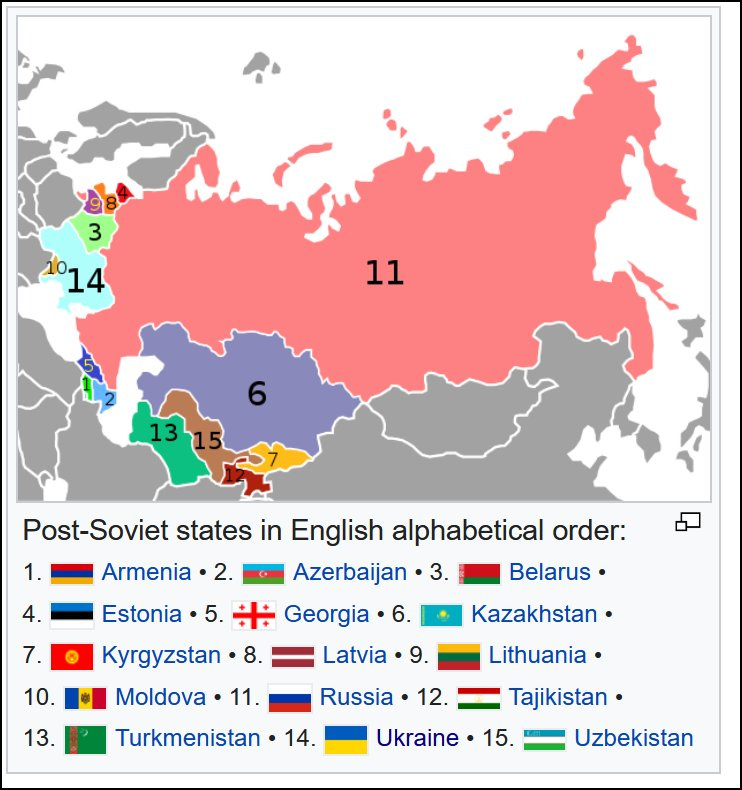
Fifteen post-Soviet states. Source: Wikipedia.
Though many of these states as well as their people have retained close ties with Russia, three of them acceded membership into NATO in 2004; namely, Estonia, Latvia, Lithuania.
Two of these countries, Estonia and Latvia share a border with Russia.
Recall that NATO originally had 12 members.
A CNBC article provides two maps showing the expansion of NATO since 1991 towards Russia. The first map shows Europe in 1990, the year after the Berlin wall fell:
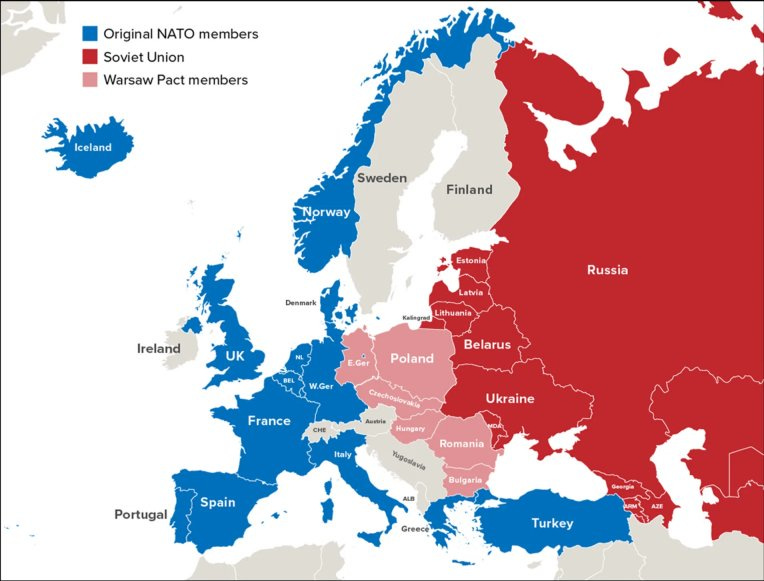
Map of Europe in 1990 showing original NATO countries in blue. Source: Bryn Bache, CNBC.
Their second map, as of 2022, clearly shows the expansion of NATO membership over the past 32 years since the reunification of Germany:

Map of Europe in 2022 showing current NATO countries in blue. Source: Bryn Bache, CNBC.
From this second map above showing 2022 NATO countries in blue, we can also notice Sweden and Finland (in light blue) who are currently vying for NATO membership.
Since the early 1990s, Russia has been worried about NATO expanding closer to its borders.
While various agreements had been made between Russia and Europe not to expand NATO eastward, several of them were broken.
The main worry is that NATO members can have military bases that hold nuclear missiles for which member countries, such as the United States, have an ample supply of.
There is plenty of evidence that confirms that such military bases (particularly from the U.S. and NATO) exist and are located in Russia’s immediate neighbors of Estonia(see also here, here and here), Latvia (see also here, here, here, here, here, here, and here) , and Lithuania (see also here, here, here, here, and here).
U.S. and NATO military bases, personnel, and operations are not limited to these three countries, for there are many more in other NATO countries near Russia such as Poland, Hungary, and Bulgaria.
In recent years, Russian President Vladimir Putin has sought guarantees from NATO and many of its European members that it would halt its eastward expansion and end military cooperation with Ukraine and Georgia, which are not members, observed Al Jazeera.
Both Georgia and the Ukraine share borders with Russia and the latter has a significantly long border with the biggest former member of the Soviet bloc.
It would thus come as no surprise that Russia and its current leader, Vladimir Putin, would consider it more than hostile should either of these two countries were to join NATO.
Many of sound mind would argue that having military bases, some with nuclear arsenals, within only several kilometers from your doorstep poses a significant threat to the safety, protection, and territorial integrity of a nation and its people.
Was this not the case when the Soviet Union had stationed nuclear missiles in Cuba, less than 100 miles away from the United States?
If that was not acceptable to President John F. Kennedy and the U.S. administration, then how is it different for Vladimir Putin, the President of Russia and his administration?
Should they not be granted the same right?
These questions must be considered and contemplated prior to outrightly accusing Putin of “aggression” and invasion against the Ukraine, or any other close neighbor, for that matter.
Also according to the Al Jazeera article, in February [of 2022], Putin said Russia’s “special operation” in Ukraine was a means to stop NATO’s growth, which he perceives as an encroachment.
Only in recent weeks has Putin called the conflict with the Ukraine a war. Perhaps this is so because he had not anticipated the level and extent of Western support Kiev has received over the past year.
While some would argue that the invasion was nevertheless unjustified, ample evidence exists that show that prior promises and agreements to not allow the expansion of NATO eastward were broken by NATO members and NATO itself.
Here are but two of these broken promises which most everyone seems to forget about.
Early last year, a secret document from March 1991 titled QUADRIPARTITE MEETING OF POLITICAL DIRECTORS, BONN, 6, MARCH: SECURITY IN CENTRAL AND EASTERN EUROPE showed a pledge to Moscow by the United States, Germany, France, and the United Kingdom, that they would not extend NATO eastward and would not offer membership to Poland.
The document was found in the UK National Archives by Joshua Shifrinson, a political science professor at Boston University in the US and shared with Der Spiegel. It had been marked “Secret” but was declassified at some point.
Specifically, here is part of what was it stated:
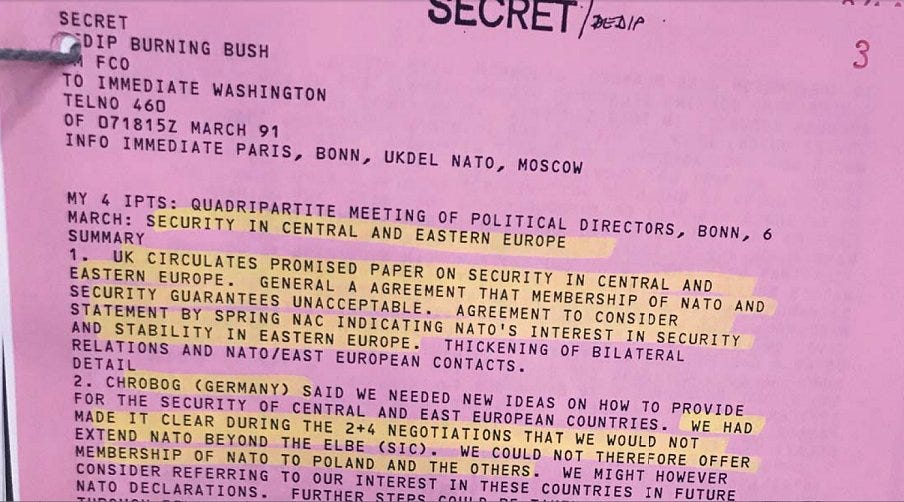
Screenshot of the 1991 QUADRIPARTITE MEETING OF POLITICAL DIRECTORS, BONN, 6, MARCH: SECURITY IN CENTRAL AND EASTERN EUROPE. Source: UCLA College of Social Sciences.
As the reader may notice from the image above, the parties stated: “WE HAD MADE IT CLEAR DURING THE 2+4 NEGOTIATIONS THAT WE WOULD NOT EXTEND NATO BYOND THE ELBE (SIC).”
The “2+4 negotiations” simply refers to the reunification of Germany (i.e., East Germany with West Germany) with NATO remaining an integral part of the reunified country.
In July 2014, NATO itself called the eastward expansion a “myth,” as per its published piece titled NATO enlargement and Russia: myths and realities. In that piece, a few questions were raised about the “enlargement conundrum” [emphasis added]:
“Does the absence of a promise not to enlarge NATO mean that the West never had any obligations vis-à-vis Russia? Did the enlargement policy of Western institutions therefore proceed without taking Russian interests into account? Again, the facts tell a different story.”
The only thing is, NATO was not counting on the QUADRIPARTITE MEETING OF POLITICAL DIRECTORS, BONN, 6, MARCH: SECURITY IN CENTRAL AND EASTERN EUROPE secret document to be released to the public.
In black and white, it confirms that a promise, or agreement, by NATO not to expand did take place.
So, this myth, or “conspiracy theory” turned out to be conspiracy fact.
It is no wonder that Moscow and Putin hold a fervent distrust of NATO, the United States, and its other Western allies.
The secret 1991 document also revealed the following:
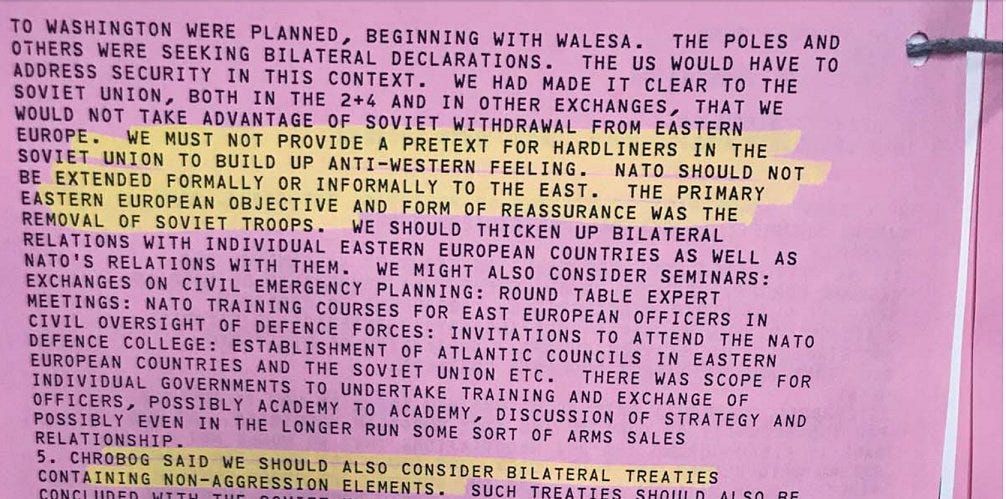
Verbatim [with emphasis added for the most salient points]:
“WE HAD MADE IT CLEAR TO THE SOVIET UNION, BOTH IN THE 2+4 AND IN OTHER EXCHANGES, THAT WE WOULD NOT TAKE ADVANTAGE OF SOVIET WITHDRAWAL FROM EASTERN EUROPE. WE MUST NOT PROVIDE A PRETEXT FOR HARDLINERS IN THE SOVIET UNION TO BUILD UP ANTI-WESTERN FEELING. NATO SHOULD NOT BE EXTENDED FORMALLY OR INFORMALLY TO THE EAST. THE PRIMARY EASTERN EUROPEAN OBJECTIVE AND FORM OF REASSURANCE WAS THE REMOVAL OF SOVIET TROOPS.”
As you can see, the promise was indeed made. The Soviet withdrawal did occur. Yet NATO expanded anyhow, including in Poland for which they had also explicitly stated they would not.
If NATO has lied about this broken promise, then how many others have they lied about and broken? And, more importantly, should they be trusted?
That is not the only promise NATO has broken with Russia.
The Minsk agreement of 2015
“The Minsk agreement, which the Russian government backed for diplomatic reasons, has served to allow Washington time to train, equip, and mobilize much stronger forces now preparing to resume the attack on Donetsk and Luhansk,” observed Dr. Paul Craig Roberts, former U.S. Assistant Secretary of the Treasury, former associate editor at The Wall Street Journal, and long time Russia connoisseur, back in 2015.
He was right.
What is the Minsk agreement?
Not to be confused with the 1991 agreement of the same name, the 2015 Minsk agreement was one that aimed to resolve the long-simmering conflict in eastern Ukraine.
The conflict was between pro-Russian separatists mostly from the Donetsk and Luhansk regions who were more ethnically Russian and the Ukrainian government.
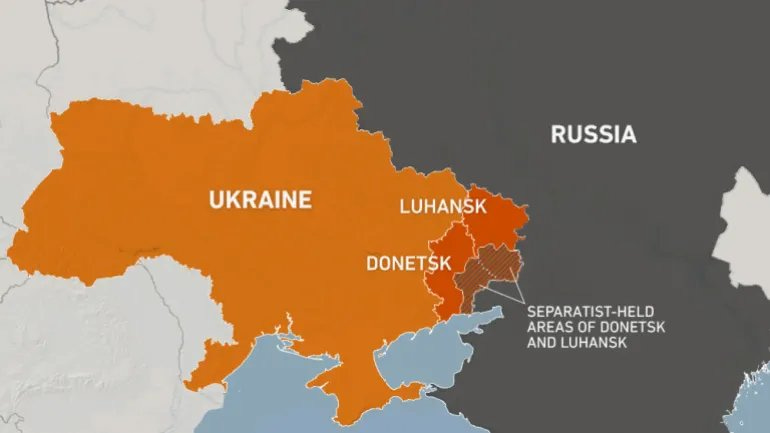
Image source: Al Jazeera.
The following passage from Reuters describes the 2015 (Minsk II) agreement in a nutshell:
“Representatives of Russia, Ukraine, the Organisation for Security and Cooperation in Europe (OSCE) and the leaders of two pro-Russian separatist regions signed a 13-point agreement in February 2015 in Minsk. The leaders of France, Germany, Russia and Ukraine gathered there at the same time and issued a declaration of support for the deal.”
The agreement ultimately failed.
Siehe auch diese Artikel
Der ukrainische Präsident Wolodymyr Selenskyj gibt zu, dass er nie daran gedacht habe, die entscheidenden Vereinbarungen von Minsk mit dem Donbass umzusetzen.
Al Mayadeen Global Research, 10. März 2023
Merkel räumt ein, dass Minsker Abkommen von 2014 eine Täuschung war
While which side is the blame is a contentious matter, the Organisation for Security and Cooperation in Europe (OSCE), who was in charge of monitoring the implementation of the ceasefire agreement, determined that the Ukrainian government had repeatedly violated the agreement and around 200 weekly violations in 2016-2020 and more than 1,000 since 2021 occurred, according to Novaya Gazeta.
Though NATO stressed that the Minsk agreements remained “the best chance to settle the conflict,” its actions proved otherwise.
Back in 2015, Jens Stoltenberg, NATO’s Secretary General since 2014, indicated no less than an increase military support to the Ukraine during this so-called ceasefire period, stating “we have stepped up our support to Ukraine on command and control; logistics; cyber defence.”
And more specifically, in June of 2022, Stoltenberg affirmed NATO’s long-time push into Eastern Europe, stating:
“the reality is that we have also been preparing for this since 2014. Because that’s the reason why we have increased our presence in the eastern part of the Alliance, why NATO Allies have started to invest more in defence, and why we have increased the readiness.”
By “increase in the readiness”, Stoltenberg was referring to Russia. On the matter, Robert Bridge, an American writer and journalist for RT noted:
“What he neglected to mention, though, was the role Western powers played in the outbreak of civil violence in Kiev on February 24, 2014 that led to the Maidan coup and, ultimately, to the current situation. The US and its influence on the ground in Ukraine, channelled through “civil society” groups it bankrolled, was largely responsibility for that mess.”
A month before the Russian invasion in 2022, Ukraine’s own security chief, Oleksiy Danilov, warned the West against enforcing the Minsk II peace deal.
Danilov also denounced the Russian demands for NATO to bar Ukraine from ever joining the alliance.
Former opposition MP Ilya Kiva (who had to flee the Ukraine for his stark opposition to Zelenskyy) blamed the Ukrainian President of supporting pro-NATO policies causing the war, allowing Nazism to permeate in the country, and enslaving his own people in the eastern part of the country.
In a March 2022 interview Kiva slammed the U.S. and NATO for “using Ukraine as bait to provoke Russia into a conflict.” He added that Washington and its allies had tricked Zelenskyy which has led to its current state of devastation.
In concluding this section, the Minsk agreements were practically doomed from the start since powerful forces influencing Kyiv, including NATO and many others mentioned in this exposition, really had no sincere interest in helping to establish peace in eastern Ukraine; but were more concerned with continuing their eastward expansion towards Russia’s borders.
2. The Maidan Coup & Victoria Nuland’s “F**k the EU”
After the dissolution of the Soviet Union in 1991, Ukraine became an independent country.
In the years 2013-2014, the Ukraine was at a real crossroads. Geographically-perched between Europe in the west and Russia in the east, alliances were split and there was a lot at stake – economically and geopolitically.
The West was calling for the young country to align itself with European and American interests.
But its President, democratically-elected Ukrainian President Viktor Yanukovych, was instead leaning towards aligning the country’s interests with Russia and Putin.
This was absolutely unacceptable to Western powers and NATO.
Consequently, Ukrainian President Viktor Yanukovych was overthrown in a violent coup on Feb. 21, 2014.

Violence during the Maidan coup in Ukraine, 2014. Source: Wikipedia.
This operation is more commonly known as the Maidan Coup in which demonstrators (against Yanukovych’s government) leadership were riddled with neo-Nazis.
A phone call (transcript here) was leaked to the news media on February 4th, 2014 between U.S. Assistant Secretary of State Victoria Nuland and Geoffrey Pyatt, the then U.S. ambassador to Ukraine.
Assistant Secretary of State Victoria Nuland with Geoffrey Pyatt, February 6, 2014.
During the call, they discussed which puppets could be installed in their new government; keep in mind, this is a few weeks before the Maidan Coup had occurred.
Nuland and Pyatt schemed on how they would form the new government post-coup placing “Yats”, Arseniy Yatseniuk as a key plant for the new government.
Arseniy Yatseniuk became the new Prime Minister of Ukraine on February 27, 2014.
And in June of the same year, NATO- and Western-friendly Ukrainian oligarch Petro Poroshenko replaced Yanukovych as the new President of Ukraine in what was a very questionable election.
This phone call is also memorable for its “Fuck the EU” reference uttered by Victoria Nuland. This was in reference to her frustration about how members of the European Union were somewhat divided on relations with Russia and thus not aggressive enough against their Cold War rival.
End of Year Report: Corruption and Repression to Save a Neoliberal Regime in Ukraine
By Dmitriy Kovalevich Global Research, January 20, 2023 New Cold War: Know Better 30 December 2022
Ukraine: Is the Hammer About to Fall?
By Mike Whitney Global Research, January 19, 2023
Turkey and Syria Meeting in Moscow May Result in Peace Plan
Posted by INTERNATIONALIST 360° on
Tomorrow, the Foreign Ministers of Turkey and Syria will meet in Moscow. This is the highest level meeting between the two countries who have been on opposite sides of the US-NATO war on Syria for regime change since 2011.
The outcome of that meeting, and the expected follow-up meeting between Turkish President Recep Tayyip Erdogan and Syrian President Bashar al-Assad, may form the basis for the recovery of Syria, circumventing the UN resolution 2254, which has failed to produce results.
Dossier der Ukraine-Analysen: Krieg in der Ukraine
Hier werden aktuelle und auch ältere Analysen, Dokumentationen und Umfragen zum Ukraine-Krieg zusammengestellt – beginnend 2014 mit dem Krieg im Donbas.
Explaining the Causes and Consequences of Putin’s Invasion of Ukraine with Mike McFaul
203.117 Aufrufe 22.11.2022
The Russian military invaded Ukraine on February 24, 2022. Why is Ukraine strategically important to Russia and the West? What are the global implications of this attack? Join Stanford Professor Michael McFaul, who served as the U.S. Ambassador to the Russian Federation from 2012-2014, for an in-depth look at the invasion of Ukraine and the policy choices facing the United States, NATO, and their allies.
Michael McFaul, ’86, MA ’86, is the director of the Freeman Spogli Institute for International Studies, the Ken Olivier and Angela Nomellini Professor of international studies and a senior fellow at the Hoover Institution and the Freeman Spogli Institute and the Woods Institute. Professor McFaul served the Obama administration as Special Assistant to the President, Senior Director for Russian and Eurasian Affairs at the National Security Council at the White House, and as the U.S. Ambassador to the Russian Federation. He has written and edited several books on international relations and foreign policy, and his op-ed writings have been featured in the New York Times, Wall Street Journal, and Washington Post. His latest book is From Cold War to Hot Peace: An American Ambassador in Putin’s Russia. In 2019, Professor McFaul received The Richard W. Lyman Award for exceptional volunteer service to alumni at Stanford.
Einleitung
Gabor Steingarts Kommentare und Grafiken
Energie-Zar Putin & die Fehlkalkulation des Westens
Wladimir Putin . Der Westen wollte ihn ökonomisch in die Knie zwingen (Joe Biden: „Die Gesamtheit unserer Sanktionen und Exportkontrollen erdrückt die russische Wirtschaft“) und plötzlich spüren wir den kühlen Lauf seiner Gaspistole an unserer Stirn.
Ukraine: Der Stellvertreterkrieg
The Pioneer Briefing Economy Edition <news@news.gaborsteingart.com>
10 Mai 2022
So haben denn die USA nach kurzem Zögern den Fehdehandschuh des Wladimir Putin angenommen. Eine verdeckte Kriegsführung ist in Gang gekommen, die alle Merkmale des typischen Stellvertreterkrieges erfüllt und drei strategische Ziele verfolgt:
Ziel 1: Reputationsmanagement für den Präsidenten. Biden will die Schmach von Kabul vergessen machen und sein Image aufpolieren, das durch Trumps Etikettierung als „sleepy Joe“ Schaden nahm. Seine Rhetorik („I think he is a war criminal”) zielt auf Zuspitzung; die Symbolik (Rede vor dem Warschauer Königsschloss) auf die traditionelle Rolle als Führer der freien Welt. Die Tatsache, dass First Lady Jill Biden als Botschafterin nach Kiew geschickt wurde, zeigt wie lustvoll und variantenreich das Weiße Haus die Bühne im europäischen Theater zu besetzen gedenkt:
„The people of the United States stand with the people of Ukraine“, sagte sie dem ukrainischen Präsidenten.
Ziel 2: Die militärische Schwächung der Russischen Föderation. Putin hat die USA geradezu eingeladen, das russische Militär zu testen. Bidens Antwort: Yes, we can. Ohne Risiko für Leib und Leben der Amerikaner und mit vergleichsweise kleinen Dollarbeträgen stürzen sich die Amerikaner in diesen Stellvertreterkrieg, der bei CNN längst auch als „Proxy War“ bezeichnet wird.
Die USA sind zum größten Unterstützer der Ukraine geworden, nachdem sie im März ein 13,6-Milliarden-Dollar-Paket an wirtschaftlicher, humanitärer und militärischer Hilfe für die Ukraine bewilligt hatten, das nun fast ausgeschöpft ist. Weitere 33 Milliarden will Biden sich vom Kongress genehmigen lassen. Insgesamt wären das rund fünf Prozent des US-Militärbudgets des Jahres 2021 – also Spielgeld.
Laut Berichten von „New York Times“ und „NBC“ gelingen der ukrainischen Armee vor allem dank des Einsatzes amerikanischer Aufklärungstechnik spektakuläre Schläge, wie die Versenkung des russischen Kreuzers „Moskwa“ und die Tötung von zwölf Generälen. CIA-Chef William Burns erklärte am Samstag in Washington auf einem Event der „Financial Times“ nicht ohne Stolz:
“Es sind nicht nur Stinger-Raketen, die Russen töten und Ausrüstung zerstören. Auch Aufklärung ist eine Waffe. “
Ziel 3: Das Decoupling zwischen den westlichen Volkswirtschaften und den autoritären Regime in Russland und China. Das Sanktionsregime gegen Russland, das auf Drängen der USA die Energielieferungen, die Zahlungssysteme und jegliche Produktionsstätten in Russland betrifft, bedeutet für die Volkswirtschaft der USA eine Stärkung. Durch die gestiegenen Energiepreise und die vollen Auftragsbücher der US-Rüstungsfirmen hat sich dieser Krieg für die USA finanziell schon gelohnt. Die drei größten US-Öl- und Gaskonzerne, ExxonMobil, Chevron und ConocoPhillips, erwirtschafteten im ersten Quartal des Jahres 16 Milliarden Euro Gewinn. Die Aktien der Rüstungskonzerne Lockheed Martin (+24 Prozent), Northrop Grumman (+18 Prozent) und Raytheon (+6 Prozent) schießen seit Anfang des Jahres in die Höhe.
Von der Rückverlagerung der Wertschöpfungsketten – mittlerweile hat Biden auch den Putin-Partner China ins Visier genommen – verspricht man sich in Washington eine Renaissance der amerikanischen Exportindustrie, die durch den Aufstieg Chinas unter die Räder geraten ist. Auch wenn Donald Trump nicht mehr regiert, sein ökonomisch konnotiertes „America first“ gilt weiterhin, jetzt sogar erst recht. Auch Biden will die blue collar workers für sich gewinnen.
Selbst in den USA wird manchem schon mulmig bei dem Gedanken, der politisch leicht lädierte Biden könnte mit seiner verdeckten Kriegsführung zu weit gehen. CNN-White-House-Reporter Stephen Collinson sagt:
“Biden muss kalkulieren, wie weit er in der Ukraine gehen kann, ohne die rote Linie zu überqueren, die Putin nie genau definiert hat. “
Auch ihm ist aufgefallen, was in diesen Tagen fehlt und was Biden gar nicht erst versucht hat:
“Es gibt bisher keine gehaltvolle diplomatische Offensive des Westens, um den Krieg zu beenden. “
Wir lernen: Die USA sind durch diesen Stellvertreterkrieg zum Paten der Selenskyj-Regierung geworden. Die Regierungschefs aus Kiew und Washington sind einander, wie die Amerikaner sagen würden, „brothers in arms“.
Fazit: Wenn das Vorgehen des amerikanischen Paten gut geht, bekommt Selenskyj den Friedensnobelpreis. Wenn es schief geht, wir Putins Armee.
Ukrainischer Botschafter Melnyk: „Dritter Weltkrieg hat begonnen“
ThePioneer Briefing Economy Edition <news@news.gaborsteingart.com>
Mi., 30. März, 11:53Andrij Melnyk ist studierter Jurist, spricht fließend Deutsch und Englisch und stammt gebürtig aus Lwiw. Seit Januar 2015 vertritt er die Ukraine – lautstark und deutlich. Von 2007 bis 2010 war er als Generalkonsul der Ukraine in Hamburg tätig. Andere Botschafter sind vom Stamme der Leisetreter; ihre bevorzugte Waffe ist der Brieföffner. Melnyk nutzt, wenn es seiner Ansicht nach nötig ist, auch den Holzhammer.
Er ist der Meinung, dass der Dritte Weltkrieg bereits begonnen hat:
“Man muss den 24. Februar 2022 schon sehr ernst nehmen als das Datum eines Dritten Weltkrieges. “
Diese Einlassung kommt zu einem Zeitpunkt, an dem die diplomatischen Bemuehungen erste kleine Erfolge vorzuweisen haben. Sie sind nicht nur kontraproduktiv sondern in Anbetracht der Dimensionen eines Weltkrieges auch absolut uebertrieben. Der Botschafter schürt die Angst der Menschen. Genau das ist sein Kalkül. Auch die Spielten mit der Angst ihrer Buerger, um sie auf Kriege einzustimmen: die Angst vor dem Kommunismus, dei Angst vor dem Terrorismus, die Angst vor den angeblichen Massenvernichtungswaffen des Irak etc.
„Die Angst ist der Fluch des Menschen.“(Fjodor M. Dostojewski)
Quelle der Grafiken und Textauszuege: Gabor Seingarts The Pioneer Briefing vom 23.05.2022 Der Titel stammt nicht von Gabor Steingart
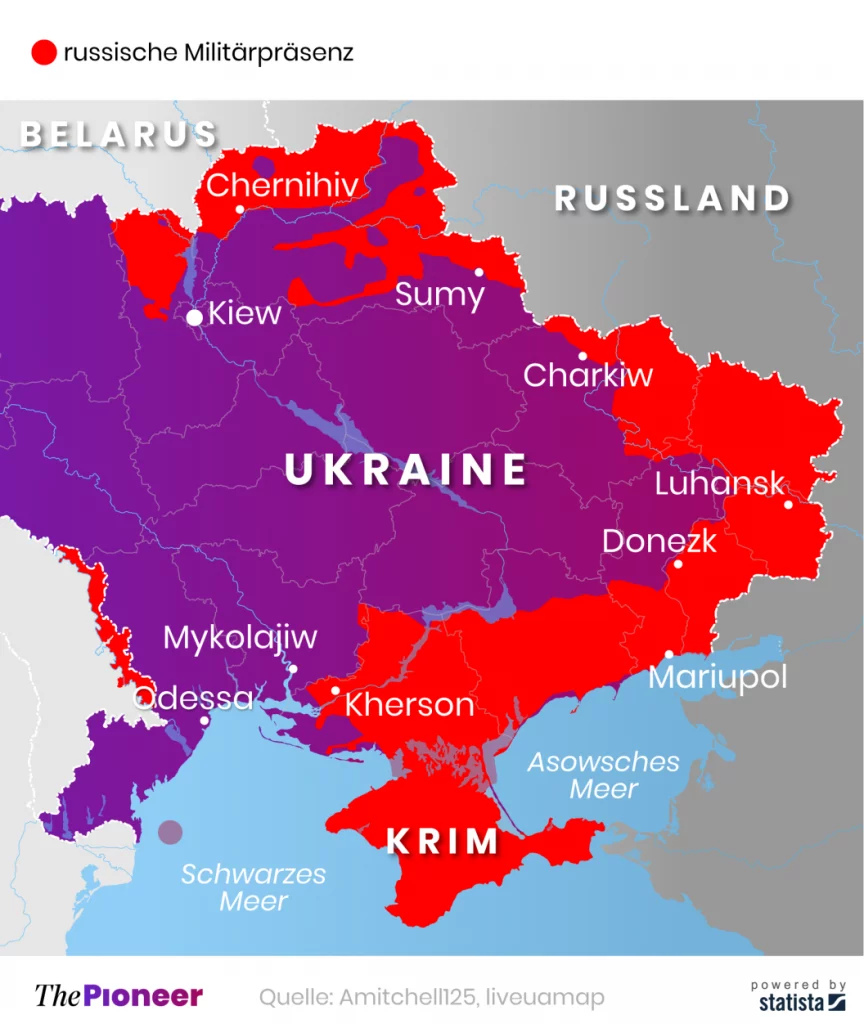
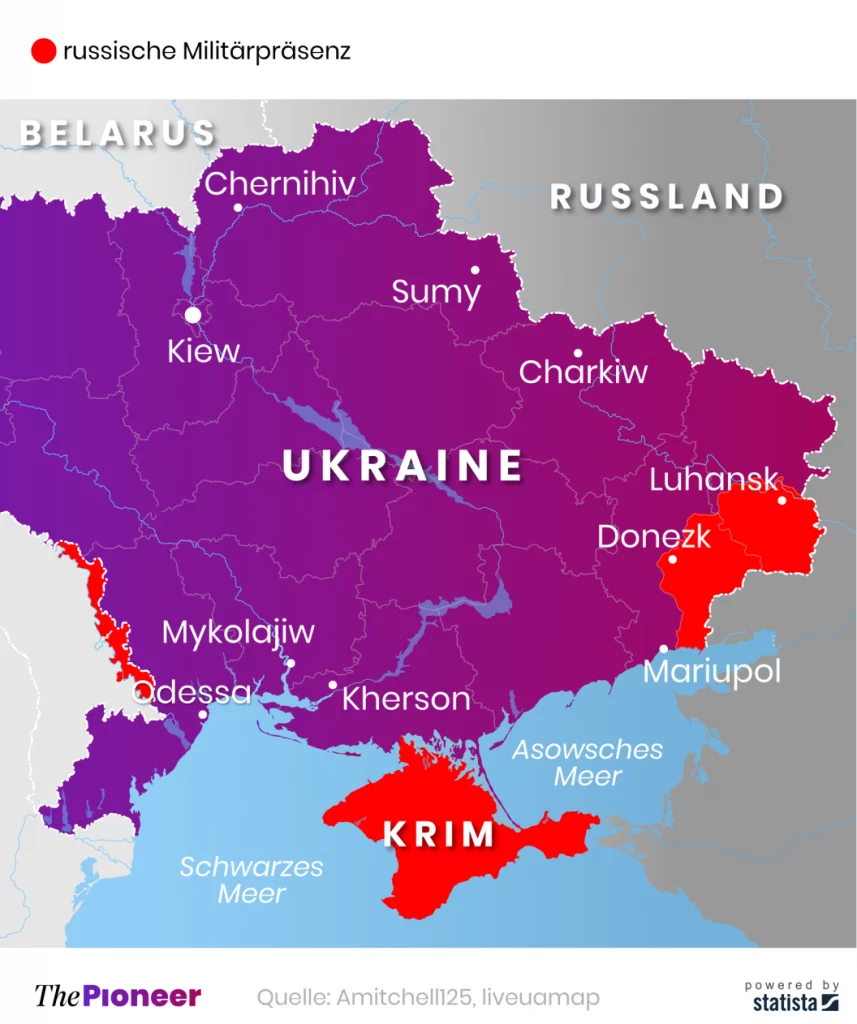
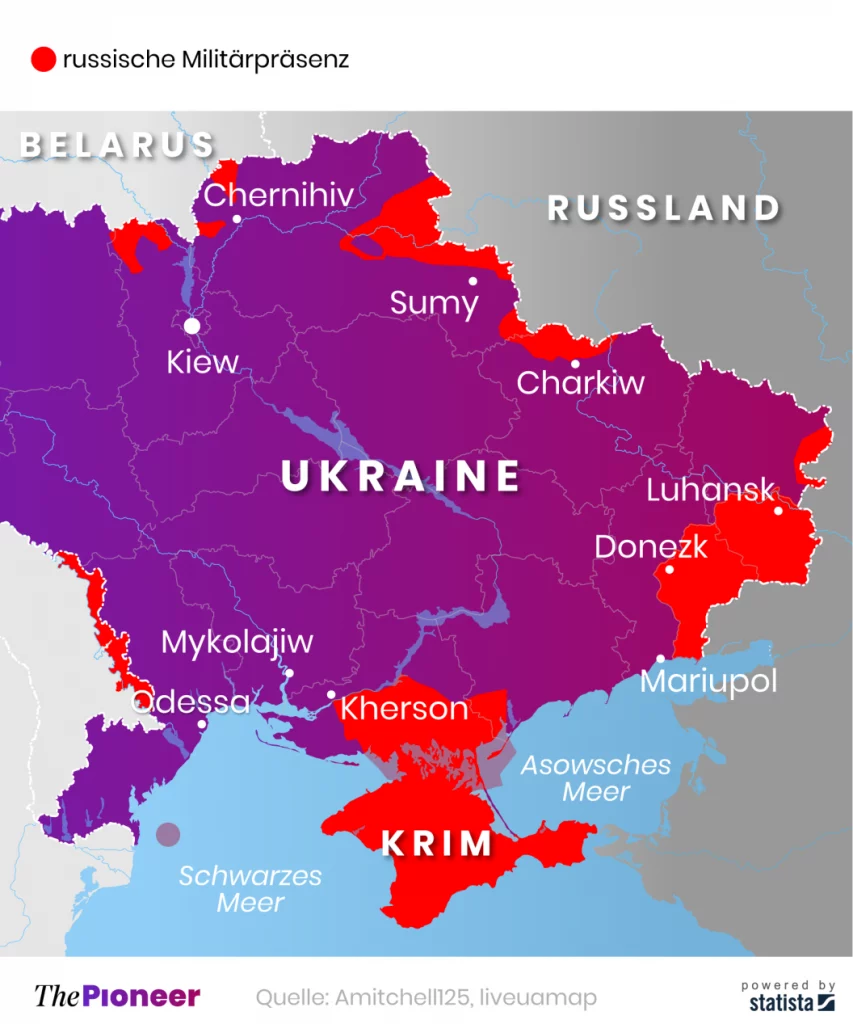
Seit dem 24. Februar führt Russland aus der Luft und am Boden einen Angriffskrieg gegen die Ukraine. Kurz zuvor hatte Präsident Wladimir Putin das Existenzrecht der Ukraine als eigenständiger Staat bestritten. Nun schlängelt sich ein 800 km langer Frontverlauf durch das geografisch zweitgrößte Land Europas.
Auf die Medienindustrie wirkt das Ganze wie ein Aufputschmittel. CNN berichtet mittlerweile mit rund 200 Journalisten, Technikern und eigenen Fahrern aus dem Kriegsgebiet – mehr als der Spiegel in Deutschland Redakteure hat. Der Krieg ist eben auch ein Geschäft; und der große Krieg ist ein großes Geschäft.
Die Firmen mit dem größten Investitionsetat im Lande sind nicht mehr Mercedes oder Siemens, sondern die Bundeswehr. Die Verteidigungsministerin darf nunmehr 150 Milliarden Euro ausgeben, derweil die Bildungsministerin sich mit 20,3 Milliarden Euro, und damit mit 500 Millionen Euro weniger als in 2021, begnügen muss. Der Staat hat seine Prioritäten neu sortiert.
Unsere heutigen Heeresberichte stammen aus der Feder von Wolodymyr Selenskyj und der Schaukasten heißt Internet. Zuweilen im Stundentakt meldet er gegnerische Verluste, spricht von zurück eroberten Teilgebieten und verkündete dann am Wochenende den finalen Schlag: Die Ukraine habe der russischen Armee „das Rückgrat gebrochen“, sagte Selenskyj in einem am Samstag ausgestrahlten Fernsehinterview:
„Sie werden die nächsten Jahre nicht mehr auf die Beine kommen. “
Doch der alte Satz „Das erste Opfer eines jeden Krieges ist die Wahrheit“ galt für den Ersten Weltkrieg, galt für Hitlers Krieg und gilt auch für Putins Krieg. Schöngeredet, frisiert und gelogen wird – und zwar auf beiden Seiten der Frontlinie.
Wer mit der langjährigen Leiterin des Nato Foresight Teams, Dr. Stefanie Babst, spricht, der bis vor Kurzem ranghöchsten Frau in der europäischen Nato, kommt zu gänzlich anderen Erkenntnissen als Selenskyj. Demnach hat die Ukraine keineswegs der russischen Armee das Rückgrat gebrochen, sondern – im Gegenteil – sie wird von eben jener Armee erwürgt. Frau Babst spricht von der Boa-Constrictor-Strategie:
„Die Russen sind von drei Seiten auf die Ukraine losgestürmt und versuchen jetzt nicht nur militärisch die ukrainischen Streitkräfte zu dezimieren, sondern auch mit wirtschaftlichen Mitteln die Versorgungslinien abzuschneiden. Man sieht das ganz deutlich im Süden am Asowschen Meer und am Schwarzen Meer: Drei Hafenstädte wurden bereits eingenommen. Die letzte noch verbleibende freie ukrainische Hafenstadt Odessa liegt unter Belagerung. “
Das bedeutet, dass es für die Ukraine keine Handelsmöglichkeiten mehr gibt. Die Häfen sind blockiert, vermint und vor dem Hafen von Odessa lauern die russischen Kriegsschiffe. Das ist eine ziemlich prekäre Situation, auch für die weitere zentrale Versorgung der Ukraine. “
Zählt man die ebenfalls besetzten Republiken Donezk und Luhansk im Südosten der Ukraine und die bereits 2014 von Russland eroberte Krim dazu, dann, sagt Frau Babst, bleibt nur noch ein ukrainischer Rumpfstaat übrig. Das sei das eigentliche Ziel der russischen Generalität:
„Russland will die Ukraine in einen Rumpfstaat verwandeln, ohne Anbindung zur See und ohne die wirklich sehr wichtige industrielle östliche Basis, also im Donbass. “
Zugleich stoße Russland immer wieder militärisch auch in den Westen der Ukraine vor, mit dem aus ihrer Sicht klaren Ziel:
„Die russische Regierung möchte damit das Stresslevel in der ukrainischen Bevölkerung weiter hoch halten. Es ist schrecklich, unter andauerndem Beschuss oder Sirenenalarm zu leben. “
Das Signal wirkt. Laut Angaben der Vereinten Nationen sind bereits 6,2 Millionen Ukrainer geflohen. Der ukrainische Rumpfstaat entkräftet sich.
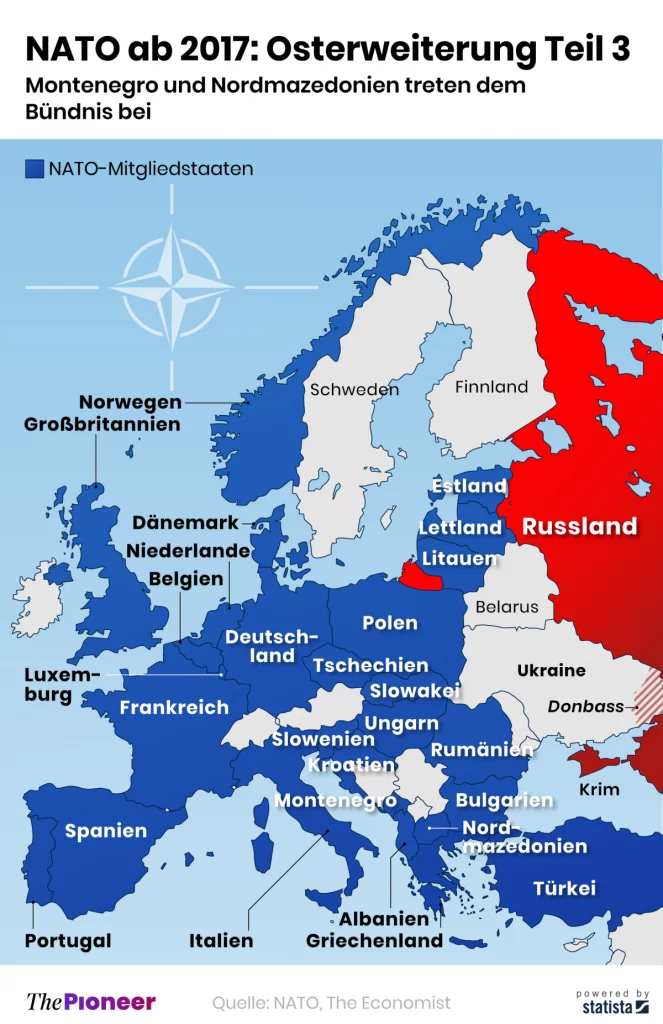

Schreibe einen Kommentar